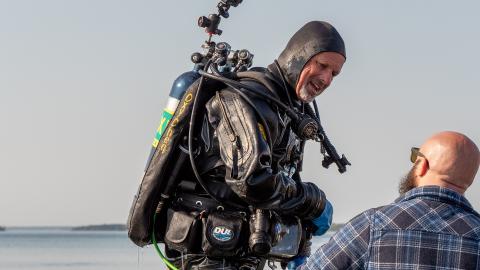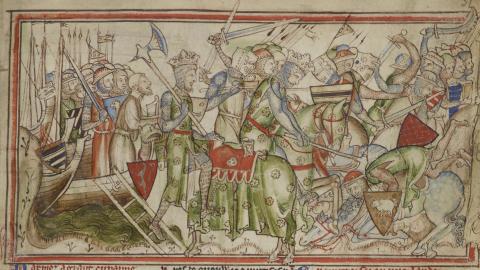‘The Battle of France is over. I expect that the Battle of Britain is about to begin.’ Winston Churchill, 18 June 1940.
By June 1940, German forces had overwhelmed the Low Countries and France using Blitzkrieg (‘lightning war’) tactics. Although the British Expeditionary Force managed to achieve a miraculous escape from the shores of Dunkirk, Britain now stood alone against ‘the menace of tyranny.’
Initially, Hitler never planned on invading Britain. Even when the Wehrmacht had taken control of French ports on the English Channel, an invasion plan of Britain was still not in the works. After France fell, Hitler hoped Churchill would sue for peace. Only after it became clear that Britain was determined to fight on did Hitler order invasion plans be drawn up under the codename Operation Sea Lion.
‘As England, in spite of her hopeless military situation, still shows no signs of willingness to come to terms, I have decided to prepare, and if necessary to carry out, a landing operation against her,’ Hitler proclaimed on 16 July 1940. ‘The aim of this operation is to eliminate the English Motherland as a base from which the war against Germany can be continued, and, if necessary, to occupy the country completely.’
Although Hitler still considered an invasion a last resort, the wheels were now in motion for the occupation of mainland Britain. Before any such invasion could be achieved, Germany needed control over the skies of southern England and the English Channel. Hermann Göring’s Luftwaffe became the Wehrmacht’s spearhead for the Battle of Britain. All that stood in their way were the pilots of RAF Fighter Command or, as Churchill would coin them, ‘The Few’.
Amongst ‘The Few’ were pilots from around the world – the Caribbean, Canada, Poland, West Africa, India and Australia were just some of the many countries that sent pilots to fly in the light blue uniform. Supporting these brave pilots were countless more men and women who worked as ground crew, factory workers, observational volunteers and radar operators.
Although outnumbered at the start of the campaign by around four to one, the RAF not only had some of the best fighter aircraft in the world (Hawker Hurricanes and Supermarine Spitfires) but was also supported by the most advanced air defence network in the world, the Dowding System.
During the inter-war years, the head of Fighter Command, Air Chief Marshal Sir Hugh Dowding, had implemented the brilliant defence system, which brought together radar technology, ground observation crews and fighter aircraft to create a unified system of defence around British shores. This allowed the RAF to rapidly and accurately respond to incoming aerial attacks, often preventing German bombers from reaching their targets or reducing their effectiveness if they did. The system effectively robbed the Luftwaffe of the element of surprise.
To successfully defend the entire British mainland, the RAF was split into four geographical areas called ‘Groups’. Sir Keith Park was in command of No. 11 Group, which carried the weight of the battle since it was responsible for the defence of South East England and London. Conducting operations in an underground bunker at RAF Uxbridge, Sir Keith Park organised his defence into small formations. In doing so, Park created a mobile, reactive and agile defence strategy that used the Dowding System to efficiently make use of the limited resources available.
From 10 July, German aircraft began to intensify bombing against British shipping and coastal targets. Their main offensive was launched on the 13 August and was codenamed Operation Eagle Attack. The aim of the operation was to completely destroy the RAF and so airfields and communication centres, especially those in the southeast of England, became key German targets.
Although Fighter Command offered fierce and stiff resistance, they soon came under immense pressure from wave after wave of German raids. 18 August would become known as ‘The Hardest Day’, as the Luftwaffe launched a monumental push to destroy Fighter Command. When the day was done, the RAF had lost 68 aircraft whilst the Luftwaffe had lost 69, a combined number that would not be surpassed at any other point during the campaign.
As August went on, the Luftwaffe began to incorrectly believe and communicate to Hitler that the RAF was weakening to the point of defeat and so began to focus their attacks on military and economic targets across the country. Whilst Fighter Command was battered and bruised, it was by no means on its last legs.
It was, however, given a reprieve and a chance to recover when Hitler ordered London to become the focus of attacks instead of RAF targets. This switch in tactics was in retaliation for a British bombing raid on Berlin and on 7 September, nearly four hundred German bombers and six hundred fighters began targeting docks in the East End of London. The date marked the start of ‘The Blitz’ and the beginning of 57 consecutive nights of German bombing on London.
The 15 September witnessed the largest Luftwaffe bombing assault yet and would become known as ‘Battle of Britain Day’. The Germans hoped to draw the RAF out into a final battle of complete annihilation. Around 1,500 aircraft took part in aerial operations that day and by dusk the RAF had emerged victorious, downing 56 German planes with a loss of just 28.
The German assault had been repelled, the tide of the battle had been turned and it was becoming increasingly obvious to German High Command that it was not going to gain air superiority over Britain. By this point, British aircraft manufacturing had also overtaken the Germans – the latter now realising they were losing bombers faster than they could produce them.
On 17 September, Hitler postponed Operation Sea Lion indefinitely and the Luftwaffe switched primarily from daylight raids to night ones. The Battle of Britain came to an end on 31 October 1940, when the final German daylight raid took place. During the course of the campaign, some 1,700 German aircraft had been downed compared to around 900 British fighters.
Although German night bombing of British cities would intensify in the coming months, Hitler’s attention soon turned east and the launch of Operation Barbarossa in mid-1941 effectively ended the threat of a German invasion on British soil.
The Battle of Britain had been a turning point in the war. Not only did it mark the first major defeat for Hitler’s forces during WW2 but it also showed to the world Germany could be defeated. With Britain left to fight on, the groundwork had been laid for Nazi Germany’s demise, as the Allies would use Britain as a base from which to launch D-day and begin the liberation of Western Europe on 6 June 1944.















